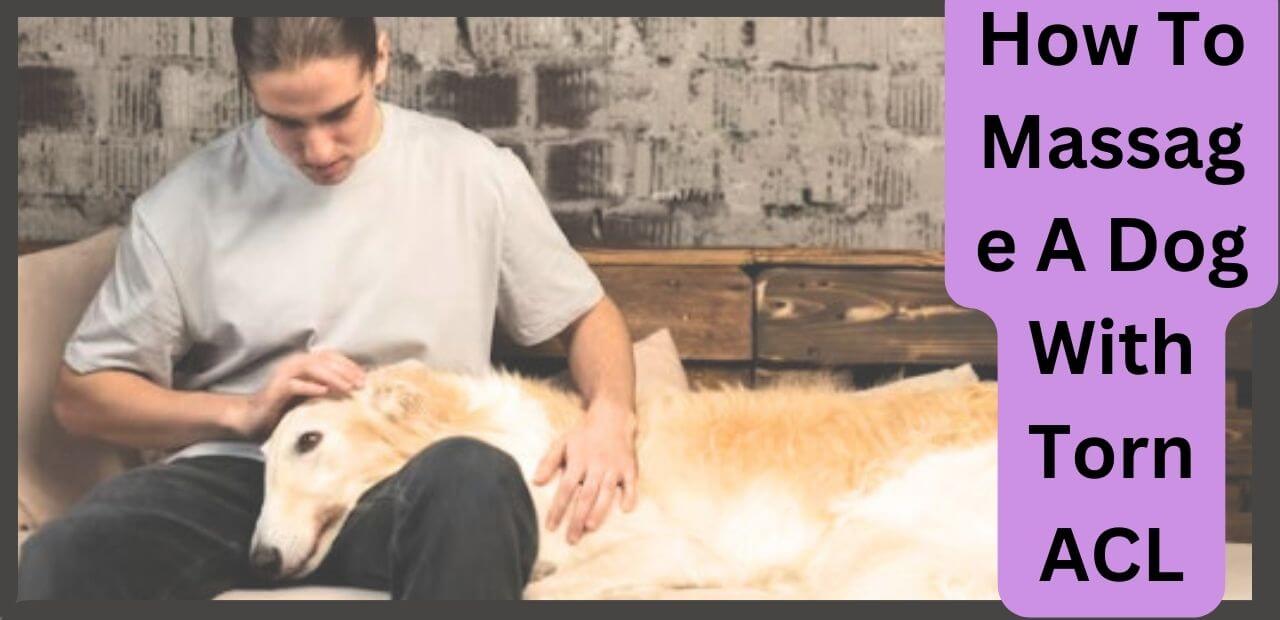How To massage a dog with a torn ACL, gently apply light pressure and circular motions around the affected area to promote healing and relieve pain. A torn ACL in dogs can cause discomfort and limit their mobility.
Massage therapy can be beneficial in reducing pain, and inflammation, and promoting relaxation in dogs with a torn ACL.
By carefully massaging the surrounding muscles and tissues, you can help improve blood circulation, stimulate the healing process, and provide relief to your furry friend.
This non-invasive technique can be a valuable addition to other treatments prescribed by your veterinarian.
In this article, we will discuss the steps and techniques of how to massage a dog with torn ACL, ensuring their comfort and aiding in their recovery.
How To Massage A Dog With Torn ACL
Massaging a dog with a torn ACL can provide much-needed relief and aid in their recovery.
Before attempting any massage, consult your veterinarian for proper guidance.
Once you have the green light, start by gently stroking the affected leg to relax the muscles.
Use your fingertips to apply light pressure in circular motions around the injury, promoting blood flow and reducing inflammation.
Be cautious not to put pressure directly on the ACL. Additionally, consider incorporating some range-of-motion exercises to maintain joint flexibility.
Regular, gentle massages can be a comforting and supportive way to assist your furry companion during their healing process.
Understanding Canine ACL Tears
Canine ACL tears, also known as cranial cruciate ligament (ccl) tears, are a common injury among dogs. Understanding the causes, symptoms, and importance of early intervention can help dog owners provide proper care and support for their furry friends.
Causes Of ACL Tears In Dogs
ACL tears in dogs can occur due to various reasons, including:
- Trauma: A sudden injury or forceful impact can cause the ACL to tear. This can happen during vigorous play, jumping, running, or accidents.
- Age and breed: Some dog breeds are more prone to ACL tears, especially those with a higher risk of joint-related issues. Additionally, as dogs age, the ligaments and joints can weaken, making them more susceptible to injury.
Symptoms And Signs Of A Torn ACL In Dogs
Identifying the symptoms of a torn ACL in dogs is crucial for early intervention. Look out for the following signs:
- Limping: Dogs may be reluctant to put weight on the affected leg or show signs of lameness.
- Swelling: The injured leg may exhibit swelling or a noticeable bump around the affected area.
- Joint instability: Dogs with a torn acl may have difficulty standing, sitting, or maintaining balance.
- Pain or discomfort: Dogs may exhibit signs of discomfort, such as whimpering, yelping, or avoiding physical activities.
Seeking veterinary attention is essential if you suspect your dog has a torn ACL. Early diagnosis and treatment can help prevent further complications and provide relief to your furry companion.
The Importance Of Early Intervention
Early intervention plays a crucial role in the treatment and recovery of dogs with torn ACL’S. It helps:
- Minimize pain and discomfort: Timely treatment can alleviate the pain and discomfort associated with a torn ACL, allowing your dog to regain mobility sooner.
- Prevent secondary injuries: Without intervention, dogs with torn ACL’S may compensate by using other limbs more, leading to additional injuries or strain on other joints.
- Enhance the chances of successful treatment: Early diagnosis allows veterinarians to recommend appropriate treatments, such as surgery or conservative management, to ensure the best possible outcome for your dog’s recovery.
Remember, always consult a veterinarian for a proper diagnosis and treatment plan tailored to your dog’s specific needs. By being proactive and seeking early intervention, you can help your furry friend get back on their paws in no time.
Veterinary Assessment And Treatment Options
Dogs, like humans, can experience torn ACL’S(anterior cruciate ligament) – a common injury that affects their hind legs. If your furry friend has been diagnosed with a torn ACL, it’s important to seek veterinary assessment and treatment options for their well-being.
A veterinary professional will thoroughly examine your dog and provide recommendations based on their individual needs. Let’s explore some of the key points regarding veterinary assessment and treatment options for dogs with torn ACL’S:
Initial Veterinary Examination And Diagnosis
- A veterinarian will conduct a physical examination to assess your dog’s range of motion, pain level, and overall condition.
- X-rays or other imaging tests may be performed to confirm the diagnosis and determine the severity of the injury.
- The vet will assess if there are any other underlying conditions that may require additional attention.
- It’s important to provide the vet with your dog’s medical history and any information about the incident or symptoms observed.
Surgical Options For ACL Tears In Dogs
- Depending on the severity of the torn ACL, surgical intervention may be recommended by the veterinarian.
- The most common surgical procedure for ACL tear in dogs is called tplo (tibial plateau leveling osteotomy). It involves altering the angle of the bones in the knee joint to stabilize it.
- Another surgical option is extracapsular repair, which involves the use of a synthetic ligament material to provide support to the affected knee.
- Surgical procedures aim to restore stability to the knee joint and improve the dog’s mobility and quality of life.
Non-Surgical Treatment Options For ACL Tears In Dogs
- In some cases, conservative or non-surgical management may be considered, especially for smaller or older dogs with specific health concerns.
- The vet may recommend a combination of rest, restricted activity, and physical therapy to promote healing and strengthen the surrounding muscles.
- Weight management plays a crucial role in non-surgical treatment plans, as excess weight places additional stress on the injured leg.
- Non-steroidal anti-inflammatory drugs (nsaids) can be prescribed to manage pain and reduce inflammation.
Remember, every dog is unique, and their treatment plan should be tailored to their individual needs.
It’s crucial to consult with a veterinary professional to determine the best course of action for your furry friend.
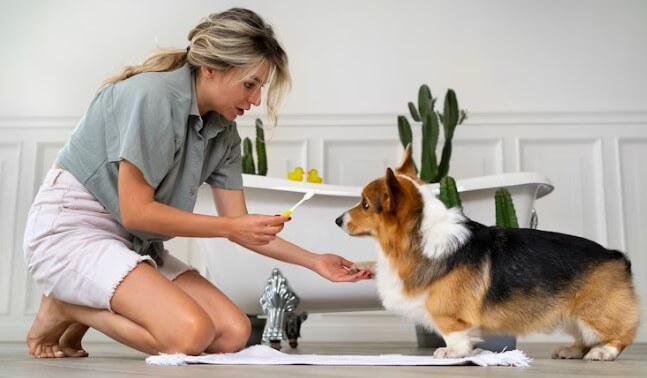
By seeking expert assessment and exploring all available options, you can give your dog the best chance of a successful recovery from a torn ACL.
Expert Massage Techniques For Soothing A Dog With Torn ACL
Dogs with a torn ACL, or anterior cruciate ligament, often experience pain and discomfort that can greatly impact their quality of life.
One effective way to help soothe their pain and promote healing is through massage therapy.
Massage can provide numerous benefits for dogs with a torn ACL, including pain relief, improved circulation, and increased range of motion.
By following expert massage techniques, you can help your furry friend feel more comfortable and support their healing process.
In this section, we will explore the benefits of massage for dogs with torn ACL, how to prepare for a massage session, step-by-step guide to massaging a dog with a torn ACL, identifying areas of pain and tension, gentle massage techniques to alleviate discomfort, promoting relaxation and stress relief, and additional complementary therapies to support healing.
So, let’s dive in and learn how to provide the best care for your dog’s torn ACL!
Lifestyle Changes For Dogs With Torn ACL
Living with a torn ACL can be challenging for our beloved furry friends. As responsible pet owners, it’s important for us to make certain lifestyle modifications to ensure their comfort and aid in their recovery.
Making the necessary adjustments can prevent further injury, provide appropriate activities for their condition, and even manage pain and inflammation through diet and supplements.
Let’s explore these lifestyle changes in more detail:
Exercise Modifications To Prevent Further Injury
- It is crucial to limit your dog’s physical activity to prevent worsening the torn ACL. Here are some exercise modifications to consider:
- Keep your dog on a leash during walks to control their movements and prevent sudden bursts of energy.
- Avoid activities that involve jumping, running, or turning sharply, as these can exert strain on the injured ligament.
- Incorporate short, frequent walks rather than long, strenuous ones to keep your dog moving and maintain muscle strength without causing excessive stress on the joint.
- Consider using a support brace or sling recommended by your veterinarian to provide additional stability during walks.
Appropriate Activities For A Dog With A Torn ACL
- While exercise should be limited, it’s important to provide appropriate activities to keep your dog mentally stimulated and prevent boredom. Consider the following options:
- Puzzle toys: Engage your dog’s mind with interactive toys that provide mental stimulation without putting strain on their legs.
- Gentle training exercises: Basic obedience training, such as sitting, lying down, or rolling over, can be a great way to interact with your dog and keep them engaged.
- Water-based activities: Swimming or hydrotherapy can be low-impact exercises that allow your dog to build strength and improve mobility without putting excessive pressure on the injured leg.
- Nose work and scent games: Let your dog explore their natural instincts by hiding treats or toys for them to find using their sense of smell.
Managing Pain And Inflammation Through Diet And Supplements
- Proper nutrition can play a significant role in managing pain and inflammation associated with a torn ACL. Consider the following dietary adjustments and supplements:
- Omega-3 fatty acids: Add fish oil or flaxseed oil to your dog’s diet to help reduce inflammation.
- Joint supplements: Look for supplements containing glucosamine, chondroitin, and msm, as these can support joint health and alleviate pain.
- Weight management: Ensure your dog maintains a healthy weight to reduce strain on the affected limbs. Consult your veterinarian for a suitable diet plan if weight loss is necessary.
- Anti-inflammatory foods: Incorporate foods with natural anti-inflammatory properties, such as turmeric, ginger, and blueberries, into your dog’s diet.
By making these lifestyle changes, you can provide your dog with the support and care they need during their recovery from a torn ACL.
Always consult with your veterinarian for personalized advice and guidance based on your dog’s specific condition.
Let’s help them heal and get back to their happy, active selves!
Rehabilitation Exercises For Dogs With Torn ACL
Importance Of Rehabilitation Exercises For Recovery
Rehabilitation exercises play a crucial role in the recovery of dogs with a torn ACL (anterior cruciate ligament).
These exercises are designed to help alleviate pain, improve mobility, and strengthen the affected leg.
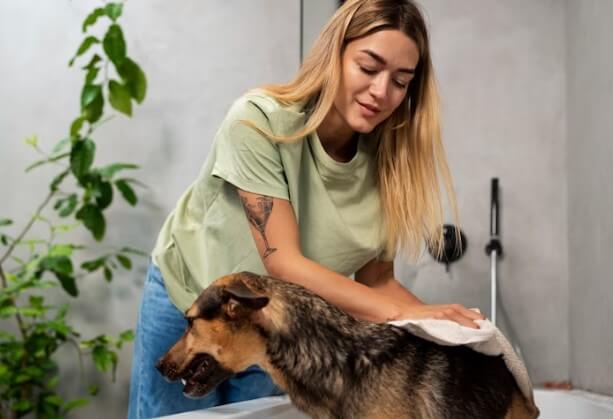
By following a consistent exercise routine, you can support your dog’s healing process and enhance their overall well-being.
Range Of Motion Exercises For A Dog With A Torn ACL
Range of motion exercises are essential for maintaining the flexibility and mobility of a dog’s affected leg.
These exercises involve gently moving the leg through its full range of motion to prevent muscle stiffness and joint tightness.
Here are some effective range of motion exercises to consider:
- Passive flexion and extension: Gently bend and straighten the leg at the knee joint to increase flexibility.
- Circles: Rotate the leg in small circles, gradually increasing the size of the circles as your dog becomes more comfortable.
- Front to back: Move the leg forward and backward, allowing the knee joint to move freely.
Remember to perform these exercises gently and slowly to prevent any discomfort or pain for your furry friend.
Strengthening Exercises To Support The Affected Leg
In addition to range of motion exercises, strengthening the affected leg is crucial for a dog with a torn ACL. Building strength in the leg muscles helps support the joint, reduce strain, and promote stability.
Here are some strengthening exercises you can incorporate into your dog’s rehabilitation routine:
- Weight shifting: Encourage your dog to shift their weight onto the affected leg by providing support and stability.
- Sit-to-stand exercises: Encourage your dog to sit and then rise back up, using the affected leg to push off the ground.
- Walking uphill or on uneven surfaces: Gradually introduce inclines or challenging terrains to help strengthen the leg muscles.
Remember to start with low-impact exercises and gradually increase the difficulty as your dog progresses in their recovery. Always monitor your dog’s comfort level and adjust the exercises accordingly.
By prioritizing rehabilitation exercises, you can greatly support your dog’s recovery from a torn ACL. These exercises not only aid in pain management but also help your furry friend regain strength, mobility, and confidence.
Working closely with your veterinarian or a certified canine rehabilitation therapist can provide further guidance and ensure the best possible outcome for your dog’s rehabilitation journey.
Preventive Measures To Avoid ACL Injuries In Dogs
Torn ACL is a common injury in dogs, causing significant discomfort and pain for our furry friends. As responsible dog owners, it’s essential for us to take preventive measures to avoid such injuries.
By following these simple tips, you can help maintain your dog’s joint health and minimize the risk of ACL tears.
Tips For Preventing ACL Tears In Dogs:
- Provide appropriate exercise routines: Regular exercise is crucial for a dog’s overall well-being, but it’s important to choose activities that are suitable for your dog’s size, breed, and age. Opt for exercises that promote muscle strength and flexibility without putting excessive strain on the joints.
- Avoid high-impact activities: Activities such as jumping, rough play, and intense running can lead to ACL injuries. Be mindful of the surfaces your dog is running on and ensure they stay away from slippery or uneven surfaces that increase the risk of injury.
- Gradually increase exercise intensity: Just like humans, dogs need time to build up their strength and endurance. Avoid sudden increases in exercise intensity and duration, as this can strain the joints and increase the risk of injury.
- Maintain a healthy weight: Excess weight puts unnecessary pressure on a dog’s joints, increasing the likelihood of ACL tears. Ensure your dog maintains a healthy weight through a balanced diet and regular exercise.
- Warm-up and cool-down: Before engaging in any physical activity, it’s important to warm up your dog’s muscles. Gentle stretching and walking can help prepare the joints for exercise. Similarly, a cool-down period helps prevent muscle stiffness and injury after exercising.
Appropriate Exercise Routines For Maintaining Joint Health:
- Walking: A daily stroll is a low-impact exercise that helps maintain joint flexibility without placing excessive stress on the joints.
- Swimming: Swimming is a great exercise for dogs with ACL injuries or those prone to it. It allows them to build strength while reducing the pressure on their joints.
- Controlled play: Engage in controlled play sessions that involve gentle movements like fetch or tug-of-war. Monitor your dog’s behavior and stop immediately if they show signs of discomfort or fatigue.
The Importance Of Regular Veterinary Check-Ups And Preventive Care:
Regular veterinary check-ups are a crucial part of preventative care for your dog’s joint health. Your veterinarian can identify any potential issues early on and provide the appropriate treatment or guidance.
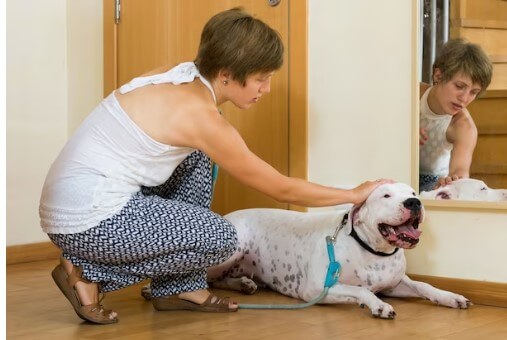
Moreover, regular vaccinations and preventive medications can help guard against certain conditions that may affect joint health.
Remember, preventive measures are key to avoiding ACL injuries in dogs.
By incorporating appropriate exercise routines, maintaining a healthy weight, and prioritizing regular veterinary check-ups, you can help keep your furry companion happy, healthy, and active.
Frequently Asked Questions
Can I Massage My Dog With A Torn ACL?
Yes, you can massage your dog with a torn ACL but it’s crucial to be gentle and consult with your veterinarian before starting any massage therapy. Massaging can provide relief and improve circulation, but it’s essential to understand the proper techniques to avoid further injury.
Is Massage Therapy Beneficial For Dogs With A Torn ACL?
Yes, massage therapy can be beneficial for dogs with a torn ACL. Massage can help reduce inflammation, alleviate pain, and promote healing by increasing blood flow to the affected area. However, it’s essential to consult with a professional who specializes in canine massage or seek guidance from your veterinarian.
What Are The Recommended Massage Techniques For Dogs With A Torn ACL?
When massaging a dog with a torn ACL, focus on gentle techniques such as effleurage (long and sweeping strokes), petrissage (kneading), and passive range of motion exercises.
Avoid deep tissue massage or applying excessive pressure to the injured area. It’s crucial to consult with a professional or seek guidance from your veterinarian for specific techniques tailored to your dog’s condition.
Are There Any Precautions I Should Take While Massaging My Dog With A Torn ACL?
Yes, there are precautions to consider when massaging a dog with a torn ACL. Avoid applying pressure directly on the injured area and be cautious about your dog’s comfort level. If your dog shows signs of pain or discomfort, stop the massage immediately.
It’s advisable to consult with a professional or seek guidance from your veterinarian to ensure safe and effective massage therapy.
How Often Should I Massage My Dog With A Torn ACL?
The frequency of massage sessions for a dog with a torn ACL may vary depending on the severity of the injury.
It’s best to consult with a professional or seek guidance from your veterinarian to determine the ideal frequency.
In some cases, massage therapy can be performed daily or a few times a week, but it’s crucial to tailor the treatment to your dog’s needs and recovery progress.
Can Massage Therapy Replace Surgical Treatment For A Dog With A Torn ACL?
No, massage therapy cannot replace surgical treatment for a dog with a torn ACL. In most cases, surgical intervention is necessary to repair a torn ACL.
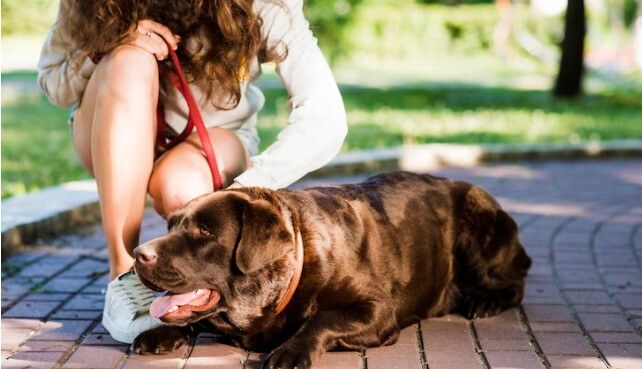
However, massage therapy can complement the surgical treatment by promoting healing, reducing pain, and supporting your dog’s recovery process.
It’s important to consult with a veterinarian to determine the most suitable course of action for your dog’s condition.
Conclusion
To sum up, massaging a dog with a torn ACL can provide much-needed relief and support during their recovery.
By understanding the proper techniques and employing a gentle touch, you can alleviate pain, reduce inflammation, and promote healing.
Remember to check with your veterinarian before attempting any massages and always listen to your dog’s cues to ensure their comfort.
Start with basic techniques such as effleurage and petrissage, progressing to more advanced methods like range of motion exercises and trigger point therapy as your dog improves.
Consistency is key, so aim for regular sessions to maximize the benefits. Additionally, combining massage with other forms of treatment, like physical therapy and pain medication, can yield the best results.
With patience, practice, and a deep bond with your furry friend, you can play an instrumental role in their recovery and well-being.
Also Read Other Post:
Can Blowing Smoke In A Dogs Face Kill Them
What Did The Bun Say To The Hot Dog
Will God Forgive Me For Putting My Dog To Sleep
